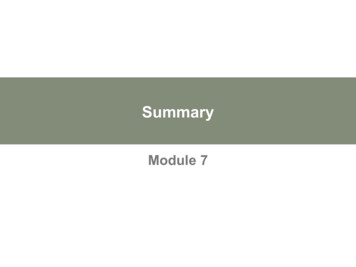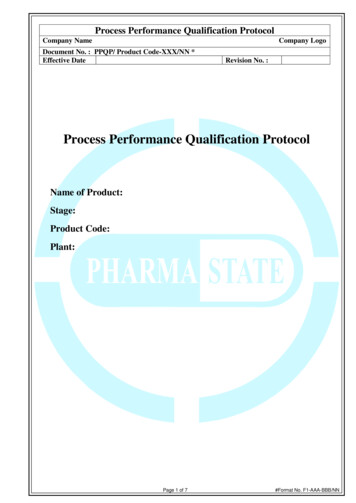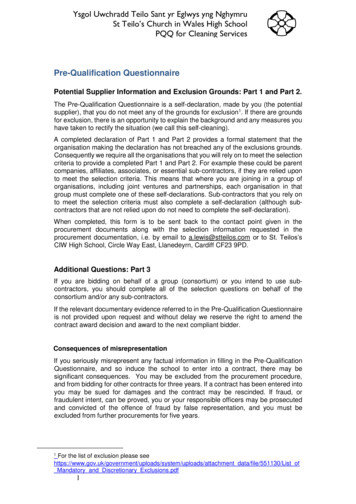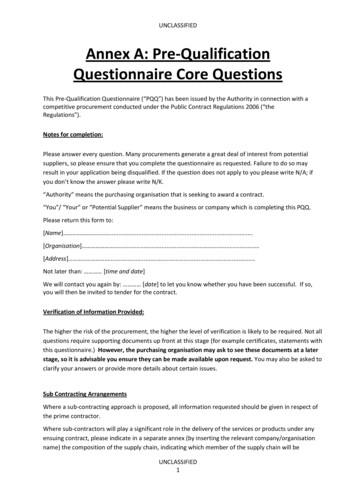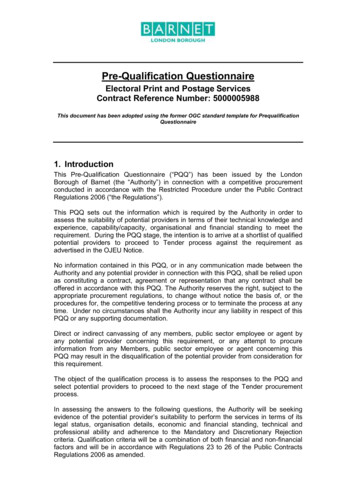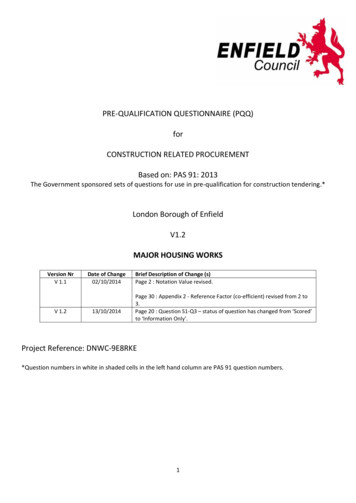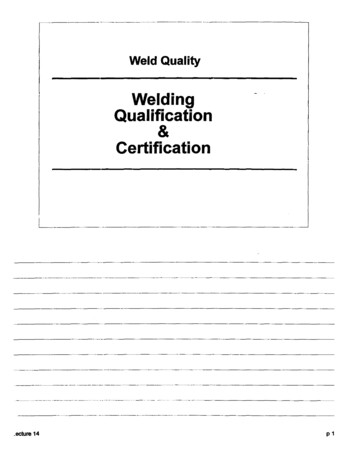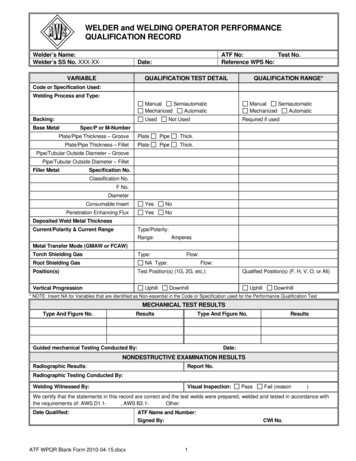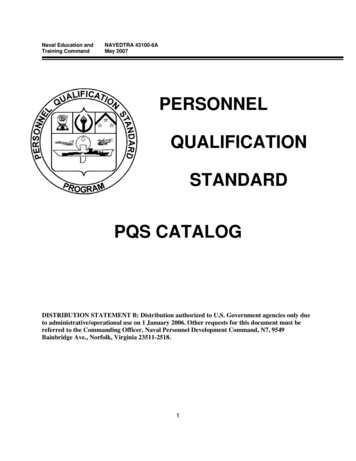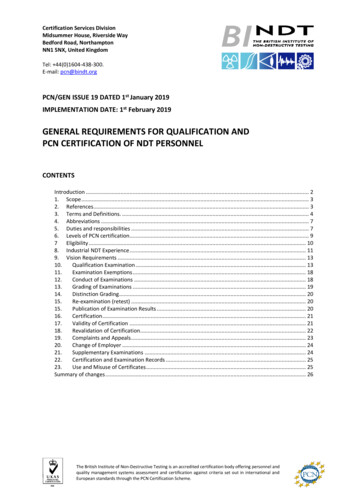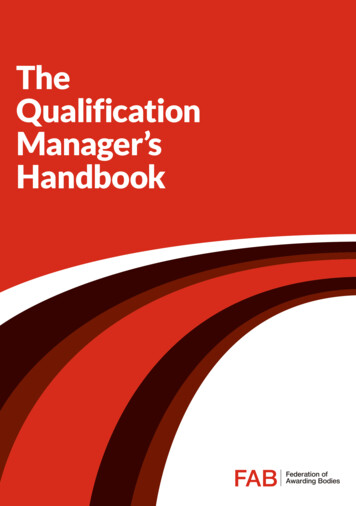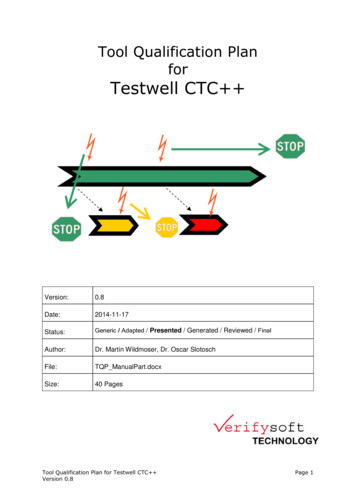
Transcription
Tool Qualification PlanforTestwell CTC Version:0.8Date:2014-11-17Status:Generic / Adapted / Presented / Generated / Reviewed / FinalAuthor:Dr. Martin Wildmoser, Dr. Oscar SlotoschFile:TQP ManualPart.docxSize:40 PagesTool Qualification Plan for Testwell CTC Version 0.8Page 1
Revision History:Version Template created0.22013-10-10AdaptedSlotoschAdapted to Testwell CTC 0.32014-01-23PresentedR. BärReviewed from Verifysoft0.42014-01-30ReviewedSlotoschEmbedded fonts as review feedback0.8 generationdate GeneratedGeneratorToolFilled model-dependent parts0.9 reviewdate Reviewed Customer Reviewed and updated1.0 finalizationdate Final Customer Finalized documentTool Qualification Plan for Testwell CTC Version 0.8Page 2
Contents1Scope of this Document . 42Glossary . 53Qualification Method . 74Validation Process. 124.14.24.34.44.5Update Tool Qualification Plan . 12Validate Qualification Environment . 12Run Validation Suite . 13Analyze Test Results . 13Write Tool Qualification Report . 145[generated tool] . 166Validation Goals. 176.1 ISO 26262 Part 8, Section 11.4 . 176.2 IEC 61508 Part 3, Section 7.4.4 . 206.3 EN 50128, Section 6.7.4 . 226.4 IEC 62304 & FDA Validation . 246.5 DO-178C / DO-330 . 296.6 Satisfying the Validation Requirements . 306.6.1 ISO 26262 . 306.6.2 IEC 61508 . 316.6.3 EN 50128 . 326.6.4 IEC 62304 and FDA Validation (Draft) . 336.6.5 DO-178C / DO-330 (TQL-5). 336.7 Test Strategy . 346.7.1 [generated errors] . 356.7.2 [generated tests] . 356.7.3 Testing Anomalous Operating Conditions . 357Qualification Environment . 377.17.27.37.47.5Test Automation Unit . 37Test Suite and Test Plan . 37Test Design Methods . 37Test End Criteria . 38Robustness Tests TF Anomalous . 388[generated qualification] . 399References . 39Tool Qualification Plan for Testwell CTC Version 0.8Page 3
1 Scope of this DocumentThis document describes how the tool Testwell CTC is going to bequalified for usage by Customer . The tool is a T3 tool according toIEC61508. Therefore the tool needs to be qualified. The appliedqualification method is “tool validation”.This document specifies the Testwell CTC in detail as it is to bequalified (see Section 5) and the validation goals (see Section 6) thathave to be shown for this tool. The validation goals are derived fromgeneral IEC61508 requirements and from the potential tool errorsidentified for the tool’s use cases in the Tool Criteria Evaluation Report[TCR], which cannot be detected or prevented with high probability withinthe development project. The Tool Criteria Evaluation Report is anISO26262 conformant document that determines the required toolconfidence (TCL) by analyzing the potential errors in the used toolfeatures and the possibilities to detect them. This work is integrated intothe argumentation as derivation of the validation goals (see Section 6).The aim of tool validation is to provide sufficient evidence for the absenceof these potential errors in the use cases of the tool. For the validationgoals a qualification environment (see Section 7) has been created and isapplied to the tool in a validation project (see Section 8) resulting in aTool Qualification Report.Tool Qualification Plan for Testwell CTC Version 0.8Page 4
2 GlossaryThis section defines technical terms used within this unctionDefinitionpossibility to detect an errorin this document used as “potential error”(model) representation of an (potential) error in the model(model) representation of a function in the model.QualificationenvironmentRestrictionSafety Guidelinean elementary or composed function of the tool, that can berequired in one or more use-cases, e.g. load, save,“perform” functionsTAU and tests, a validation suite according to ISO 26262possibility to avoid an errorGuideline to mitigate some potential errors of the tool.Modeled as a Check or Restriction, either in an usualUseCase or Feature of the Tool, or in a separate, virtualFeature that can be required (added) by any use case of thesame tool. Safety Guidelines are listed in the toolclassification report and applied in the tool safety manual.softwareoff-line According to IEC61508-4-3.2.11: software tool thatsupporttool supports a phase of the software development lifecycle and(IEC 6108)that cannot directly influence the safety-related systemduring its run time.TAUTest Automation Unit: executes tests for the test suiteTDTool Error Detection (TD) probability for a potential error tobe detected / avoided in a defined processTD1 high detection probability,TD2 medium detection probability,TD3 low or unknown detection probabilityTCL (ISO 26262-8) Tool Confidence Level (ISO 26262): required confidence inthe tool when used in the analyzed tool chainTCL1 low confidence required ,TCL2 medium confidence required,TCL3 high confidence required1TCRTool Classification Report, also called tool criteria evaluationreport in ISO 26262TestSingle test with result PASS/FAIL/ABORTTest DirectoryA directory containing one or more test (directories)Test(model) Representation of a test directory in the model including aelementtest description that specifies itTest Suitestructured set of single testsTest Planlist of test (directories) to be executedToola development tool according to ISO 26262Tool Chaina collection of tools, not necessarily forming an input/outputchain1Of course once the tool with TCL 1 have been qualified, the TCL can be regarded asexisting tool confidence for the qualified ASIL rather than required tool confidence.Tool Qualification Plan for Testwell CTC Version 0.8Page 5
Toolclasses Software off-line support tools are classified into the(IEC 61508-4)following tool classes:T1: generates no outputs which can directly or indirectlycontribute to the executable code (including data) of thesafety related systemT2: supports the test or verification of the design orexecutable code, where errors in the tool can fail to revealdefects but cannot directly create errors in the executablesoftwareT3: generates outputs which can directly or indirectlycontribute to the executable code of the safety relatedsystem.Tool Classificationdetermination of the required tool confidence level(ISO26262: TCL or IEC 61508: tool classes)Tool Evaluationor tool criteria evaluation: see tool classificationTQPThis Tool Qualification PlanTQRTool Qualification Report, extension of this documentaccording to [QKit UM]Use-Casethe purpose of using the tool in development processUse Case (model) representation of an use-case in the modelelementVirtual FeatureA Feature is called virtual, if it’s virtual attribute is set totrue. Virtual Features are modeled in a Tool, but are notimplemented in the tool. They are used to model safetyguidelines (documents) and can be added flexible asrequired features to use cases to denote that the use casesfollow them. Virtual feature do not have errors.Note that elements, relations and actions from the model that have aformal semantic in the TCA are written in capital and with italic font, e.g.“Error element”, or “Export - Excel Review”Tool Qualification Plan for Testwell CTC Version 0.8Page 6
3 Qualification MethodThe relevant safety standards have comparable approaches to toolqualification. In all standards the goal is to ensure that the tools can notimpact the safety of the product, i.e. that all potential errors of the toolare either absent or cannot impact the safety. And all standards do this bya combination of application and installation methods. The applicationmethods are safety guidelines that explain how to use the tool andavoid/detect the potential errors, while the installation methods ensurethat the installed tool works as expected, e.g. by testing it to show theabsence of the potential errors.All standards have a classification phase to determine the requiredconfidence into the tool and a qualification phase that provides thisconfidence or restricts the usage of the tools to confident scenarios.However the classification and qualification methods differ in some details.Nevertheless our qualification approach is suitable for all standards anddoes not require unnecessary work.Figure 1: Comparison of Qualification ApproachesFigure 1 gives an overview on the different approaches. The maindifference between ISO 26262 and the other standards is that theclassification of tools depends on the analysis of the potential errors andtheir detection, which increases the variability of the classification. Theimpact and the supported methods/processes are considered in allstandards as part of the classification. While the ISO does not differentiatebetween kinds of the tools the other standards do and classify the toolsfor constructive methods (e.g. code generators and compilers) as morecritical than the other tools verification, automation and analytic tools. TheTool Qualification Plan for Testwell CTC Version 0.8Page 7
results of the classification is the confidence needs (represented in pinkcolor in Figure 1). The DO expresses the tool confidence requirement bycriteria 1-3 the ISO 26262 as tool confidence levels and IEC 61508 and EN50128 as tool classes T1-T3. The next step is to derive the qualificationmethods from the qualification needs of the tool and the criticality of thedeveloped software. ISO 26262 and DO 178C, DO 278A do have tablesthat map the software criticality to qualification methods, e.g. a validationis required from ISO 26262 for TQL 3 tool in ASIL C and D projects. In DOthe qualification methods are determined by the tool qualification level(TQL) that is the interface to the DO-330 and determines the developmentof the tool, which is a specific qualification method. This criticalitydependent selection of qualification methods is depicted in Figure 1 usinggreen dotted lines. The qualification methods differ also. While the DOallows only the development according to the DO-330, a safety standard(SS), the other standards include also a proven in use argumentation(PiU) and a process assessment (PA). Since DO-330 requires also avalidation, the validation is the only method that is applicable in everystandard. Furthermore the analysis of potential tool errors and theirdetection (TD) is required in every approach for tools that have impact.Therefore this classification report contains the determination of the toolconfidence need and the analysis of the potential errors and theirdetection, that belongs to the classification in the ISO 26262.The qualification method is tool validation by testing the safety relevantparts of the tool. The safety relevant parts are determined by the toolchain analysis together with the determination of the qualification need.We formalize the tool chain to determine the required confidence usingthe following model: Use case: describes an application scenario of the toolFeature: a tool function utilized in use casesPotential error: a potential error that could occur during theapplication of a toolError mitigation: a check or restriction applied during the tooloperation phaseQualification: a method to show that a tool or a feature satisfies itsspecified requirements by demonstrating the absence of potentialerrors.This tool qualification plan describes the validation of the tool to show theabsence of the potential errors.Tool Qualification Plan for Testwell CTC Version 0.8Page 8
Figure 2: Derivation of Tool Safety Manual ContentsThe safety manual for a tool has to contain the mitigations against allpotential tool errors that are considered during tool evaluation [TCR]. Theerrors can be grouped into the three classes (see Figure 2): Potential errors in unused features (green in Figure 2)2: Using thesefeatures is prohibited in the safety manu
0.1 2010-02-10 Generic Slotosch Template created 0.2 2013-10-10 Adapted Slotosch Adapted to Testwell CTC 0.3 2014-01-23 Presented R. Bär Reviewed from Verifysoft 0.4 2014-01-30 Reviewed Slotosch Embedded fonts as review feedback 0.8 generation date Generated Generator Tool Filled model-dependent parts 0.9 review date Reviewed Customer Reviewed and updated 1.0 finalization
